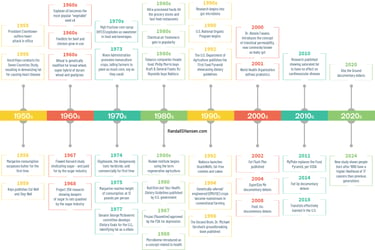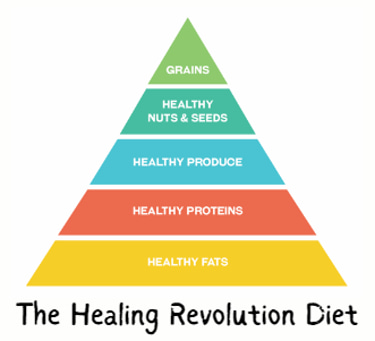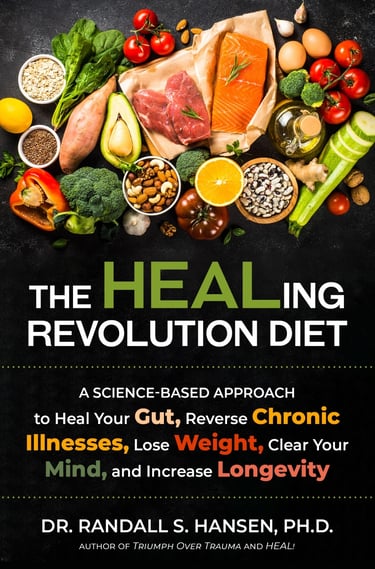Timeline of Our Food & Health Demise
What has happened in the past 75 years to so radically change the health of most of the Western world, and now even into many developing countries?
It’s the food. It’s everything about the food, from the types of foods we are now growing and producing to the types of convenience foods we are now eating for many meals. It’s the vast increase in sugar in all food products, the prevalence of cheap seed oils in place of healthy fats, and the vast amount of added chemicals (from pesticides in the growing to preservatives and emulsifiers in the final product) in our food system.
Please review this timeline of events that have had a direct influence on our food and nutrition. Included are key events from:
Chemical Industry
Healthcare Industry
Pharmaceutical Industry
Food Industry
Farming Practices
Governmental Policies and Subsidies
Health Agencies
Documentary Films
Groundbreaking Authors
We are suffering from the most serious physical and mental health crisis ever seen. Many people are suffering from insulin resistance, diabetes, heart disease, dementia, and cancer, as well as struggling with weight and obesity. A growing number of people are struggling with anxiety, depression, OCD, addiction.
Here are some of the major milestones that have led to declining healthspan.
1955: President Eisenhower suffers a heart attack while in office, triggering near-hysteria over this new disease affecting more and more Americans. This event started a “contest” for researchers to uncover what was causing this deadly disease.
1956: Ancel Keys conducts his Seven Countries Study, resulting in demonizing fat for causing heart disease; years later, researchers reviewing his work find that sugar actually has a much higher correlation to heart disease than fat.
1958: Margarine consumption surpasses butter for the first time, showcasing the progress of seed oils over natural, healthy fats, and the beginning of decades of fearing beneficial fats while replacing them with cheap and dangerous products made from seed oils.
1959: Ancel Keys publishes Eat Well and Stay Well, which stressed the “dangers” of fat in affecting people’s hearts, arteries, and blood cholesterol levels. He adamantly defended his research to the point of bullying any researcher who questioned his misguided findings.
1960s: Wheat is genetically modified for bread wheat, a super hybrid of durum wheat and goatgrass, which leads to much greater yields and profits, but greatly impacts the quality. Experts say this change is part of the problem with some gluten sensitivities.
1960s: Feedlots for beef and chicken grow in use, resulting in the industrialization of meat production. With feedlots come pollution and environmental issues, animal welfare concerns, and the beginning of a massive increase in the use of cheap grain feed, as well as routine administering of antibiotics and growth hormones.
1960s: Soybean oil becomes the most popular “vegetable” seed oil, used in many ultra-processed packaged and fast foods because of its extremely low cost to food manufacturers thanks to U.S. government subsidies. Soybean oil is also often labeled as “vegetable” oil.
1967: Flawed Harvard study vindicating sugar as safe – and paid for by the sugar industry. The impact of this study reinforced the finding from Keys, until decades later when the sugar funding was discovered. Furthermore, the fallout from this study reinforced the importance of always examining what entities provided the funding for food research studies.
1968: Project 259, research showing serious dangers of sugar in rats, is quashed by the sugar industry – and buried for decades until the truth was eventually discovered.
1973: The Nixon Administration promotes monoculture crops, telling farmers to plant as much corn, soy as possible, further promoting the wrong crops and the worst type of farming.
1974: Glyphosate, the toxic herbicide, sold commercially for first time, fostering the beginning of a massive love affair with conventional farmers, who drench crops in it at least twice during the growing cycle.
1970s: High fructose corn syrup (HFCS) explodes as a sweetener in food and beverages because of its cheap cost compared to refined sugar, because corn is highly subsidized by the U.S. government.
1975: Margarine reaches height of consumption, at 12 pounds per person.
1977: Senator George McGovern’s committee develops Dietary Goals for the U.S., identifying fat as a villain, beginning the government’s deeper involvement in recommending nutrition and food guidelines.
1980: Nutrition and Your Health: Dietary Guidelines released by the U.S. Department of Agriculture (USDA) and Health and Human Services (HHS), stressing nutritional advice.
1980s: Ultra-processed foods hit grocery stores and fast food restaurants, forever changing the landscape of food production. Food scientists were hired to chemically alter food ingredients to make foods hyperpalatable – with pleasure points to hijack the brain and make the foods addictive.
1980s: Chemical air fresheners gain in popularity, adding to the ongoing onslaught of chemicals in the home, including toxic cleaners, laundry detergents, dryer sheets, and more.
1980s: Rodale Institute begins using the term “regenerative agriculture,” a turning point for understanding how farming practices can enhance the soil rather than destroying it.
1980s: Tobacco companies invade food; Philip Morris buys Kraft & General Foods; RJ Reynolds buys Nabisco. Taking the marketing power from their success with cigarettes, these companies pushed for the development of hyperpalatable, addictive foods.
1987: Prozac (fluoxetine) approved by the FDA for depression, opening the door for the huge influx of antidepressants to hit the market. Unfortunately, these medications barely performed better than placebos and were only tested for short-term use; furthermore, they were developed with a now outdated theory that depression was due to a serotonin imbalance.
1988: “Microbiome” introduced as a concept related to health, which slowly opens the door to reexamining the gut as a key component of health.
1990: U.S. National Organic Program begins to help consumers navigate a growing problem of too many chemical residues on conventionally grown fruits and vegetables, drawing key distinctions and showing the benefits of buying organic.
1990s: Research begins into gut microbiota. Building on the concept of the gut microbiome, researchers dive deeper into all aspects of the gut and intestinal system.
1992: The U.S. Department of Agriculture publishes the First Food Pyramid showcasing dietary guidelines, further stepping into its role in educating consumers about the best daily food consumption. Unfortunately, these guidelines were completely wrong, misguided.
1992: Nabisco launches SnackWell’s, fat-free cookies and cakes, which propels no-fat products as a top food category, with many other food marketers adding low-fat and no-fat products, which often have added sugar and numerous chemicals to make up for the fat.
1994: Genetically-altered/engineered (GMO/GE) crops become mainstream in conventional farming, mainly because they increased yield – and thus profits. Organic foods cannot contain any GMO ingredients.
1998: The Second Brain, Dr. Michael Gershon’s groundbreaking book published, which focuses on the then-discovery of nerve cells in the gut acting as a “second brain,” and coordinating with the brain in our head.
2000: Dr. Alessio Fasano, introduces the concept of intestinal permeability, now commonly known as leaky gut, with underwhelming response and questions; of course, we now know that leaky gut is a major driver in toxins entering the bloodstream.
2001: The World Health Organization defines probiotics as “live microorganisms which when administered in adequate amounts confer a health benefit on the host.” Live probiotic cultures are part of fermented foods and probiotic-fortified foods, and are also available as supplements.
2002: Fat Flush Plan, by Dr. Ann Louise Gittleman, is published; a book that changed the course of the author’s life. The plan focuses on increasing metabolism, flushing out bloat, speeding up fat loss, and decreasing inflammation, but the biggest takeaway was her demonization of processed sugar.
2004: SuperSize Me documentary debuts in which Morgan Spurlock, an American independent filmmaker, filmed his consumption of McDonald's food for 30 days. The results on his health in just that short period were shocking, though it has since been reported he was also heavily drinking during the filming.
2008: Food, Inc. documentary debuts, and for the first time, viewers get a firsthand account of the dangers of the industrial production methods used in the American food industry, with the film exploring how corporations place profits before consumer health, worker safety, and the environment.
2010: Research published showing saturated fat to have little to no effect on cardiovascular disease, ending decades of misinformation and incorrect nutritional guidance. If not fat? Sugar.
2011: MyPlate replaces the Food Pyramid, with the USDA attempting to appeal to consumers with a different image, but the same bad advice of eating lots of carbs and several glasses of dairy.
2014: Fed Up documentary debuts, which examines the obesity epidemic, including the associated problems of diabetes and heart disease. The filmmaker makes the case that ultra-processed foods, and specifically the massive amounts of added sugar, are a critical underlying cause of the health crisis.
2018: Transfats effectively banned in the U.S. Transfats are artificial, hydrogenated vegetable oils that have serious health consequences, including increased likelihood of heart disease. Transfats were an inexpensive substitute for butter and lard, and used in the production of cookies, crackers, bread, frozen foods and more; many restaurants used transfats for frying.
2020: Kiss the Ground documentary debuts, which makes the premise of the power of regenerative agriculture to help heal the world’s soils, completely and rapidly stabilize the Earth’s climate, restore lost ecosystems, and create abundant food supplies. It highlights the important role healthier soil plays.
2024: New study shows that people born after 1990 have a higher likelihood of 17 cancers than previous generations. These cancers are linked to poor diet (including the high amounts of sugars and seed oils along with the almost elimination of fiber), and include pancreatic, kidney and small intestine cancers.
Final Thoughts on the Food & Health Demise Timeline
It’s fairly clear from the timeline that our health crisis has been decades in the making, some of it perhaps by accident, but others driven purely by money – the focus on the cheapest ingredients, expanding yield in crops and animals at all costs, and the drive for profits over health consequences.
For people interested in improving health, in finding healing, there are decades of momentum to overcome – but it’s possible. People are winning every day. They are winning by learning the truth about all these industries and companies working against us and by listening to their bodies and brains and guts – and eating only the best real foods that foster their health.
You can do it too! Don’t be a victim any longer; you can be a survivor! You can have better health and a longer healthspan. Information and knowledge are the key.





